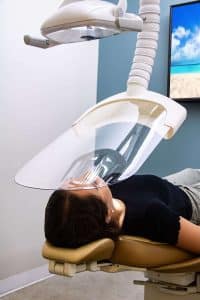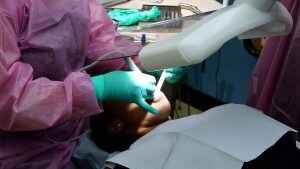
Search for topics or resources
Enter your search below and hit enter or click the search icon.
September 10th, 2020
3 min. read

Unless you’re a bull rider, 8 seconds may not mean a lot to you. Did you know that 8 seconds is the amount of time a bull rider must stay on for a ride to be scored? Well, 8 seconds just got real in dentistry. When was the last time you tested the efficiency of your high volume suction or dental vacuum altogether? Never? Well, you are not alone. In a recent CE course presented by Rella Christensen, “Your high volume suction must be able to suck 1 liter of liquid in 8 seconds to be able to capture 89-91% of the aerosols created during a dental procedure...” But even if it does, the other 9-11% of aerosols remain in the operatory. That’s not good enough!
I am a long time contributor to Dentaltown and a frequent patron (or might I say troll) on certain Facebook Groups. There are some topics I would rather creep on than comment. Dental office aerosol containment is a hot issue. There are so many opinions out there. My favorite is the dentist guy who claims COVID transmission in a dental practice is not proven - that there is no evidence that dental office aerosols pose no threat. The question is are you willing to risk it?
Aerosols have the potential to carry deadly viruses throughout your practice, exposing both clinicians and other patients. What will you do about it? A couple of weeks ago, I wrote a blog about innovation in the dental handpiece space (the electric Bien Air dental handpieces, takes the cake!). I wanted to keep talking about innovation and innovators.
Exposure to aerosol; that hot topic that no one seems to know a lot about. One thing we do know is that wearing masks and establishing barriers is working in reducing the spread of COVID. “Six feet apart”, they say. Well when was the last time “they” saw a dentist? In dentistry, we have to figure out what this barrier looks like; we’ve added plexiglass barriers between the front desk and the public, we’ve initiated some sort of preventative rinse measure and heightened disinfection protocols. But what are we actually doing for the practitioner? In addition to masks, we need a solution for the aerosols not captured in a suction - a solution that provides a barrier much like the ones you would find at a bank, grocery store and - yes - your front desk. But how can you do this in an operatory? It’s innovation, I tell ya!
Only a dental “front-liner” can solve the problem, and a dental front liner did! When Dr. David Ahearn saw the brewing pandemic, he acted (again). The fact is, he’d been concerned about aerosol control since the tuberculosis threat of the early 90’s. At that time, he designed negative pressure rooms into his practice - long before OSHA’s recommendation (see the OSHA 3990 doc). . But the current COVID crisis showed a much higher incidence of aerosol contamination and he knew he needed a solution that addressed the issue directly at the source.
That solution was the Safe-T-Shield. You’ve probably heard us talk about it, but I wanted to give you that back story, and then lay out the science in a pretty straight forward way. I’ll let the marketing guys do the fancy stuff - I want to give you “ just the facts, ma’am,” and here they are:
In addition to large particle/droplet spread, studies (ask me!) show that aerosols play a BIG role in COVID transmission. And the amount of time you’re exposed - and the closeness to the source - are important. By aerosols, I’m not talking just about fine spray from instruments. I also mean particles below the .1mu size that can remain suspended for longer periods – for instance, standard respiration – pose a significant threat!
The unique design of the Safe-T-Shield addresses both elements. Here’s how:

1. A physical barrier prevents droplet and bioburden contamination at the source, before angled vectors can spread the material to a large area.
2. The 130 CFM Shield intake flow is dispersed across a broad surface, which creates a laminar flow across the Shield. This flow, in turn, creates a broad negative pressure zone that actively controls aerosol flow from multiple sources – oral and nasal exhalation as well as that generated by instrument use.
3. The curved form of the Shield provides a substantial containment volume – over 3700ml. At 7 times the standard tidal flow (500ml for adult males), constant containment is simple. However, this large volume allows the Shield to handle spikes in aerosol levels, such as those created from sneezing/coughing/instrument use.
4. Because the Shield is positioned directly above the oral cavity, this barrier protects all clinicians in the area, rather than biasing to one side or the other (and thereby exposing an assistant).

So that’s the difference between what Dr. Ahearn created, and the other so-called “solutions” you might see out there; the ones that don’t cover the oral cavity or try to run suction off the HVE itself. Yes - and I can’t stress this enough - when it’s used properly, good HVE is a critical piece of the puzzle and is a prime line of defense. But to be effective, it has to be done right - all the time, every time. Ask yourself an honest question: are ALL your assistants that thorough? Would you bet your health and safety on the answer? And even still - the patient is sitting in that chair, without a mask, for a good chunk of time when the HVE isn’t running.
This is the real deal, my friends! It’s time to make some important decisions...
Angie Bachman, a seasoned professional with 32 years of experience in dentistry, has dedicated the last 14 years to traveling weekly across North America as Design Ergonomics' Director of Clinical Education and Training. As a dental consultant, lecturer, and frequent contributor to Dentaltown and social media dental groups, she passionately implements tools that streamline dental practices, making work easier for dentists and their teams. Angie loves exercise, running, kickboxing, cooking, and growing dahlias. In her free time, she goes to the beach with her husband and her standard sheepadoodle, Hamilton Bruce.